We’ve all experienced those Monday morning blues when walking into a sterile office environment feels more draining than energizing. The fluorescent lights and blank walls don’t exactly spark creativity or boost our mood. But what if we told you there’s a simple solution that can transform your workspace into a vibrant productive haven?
Indoor office plants aren’t just decorative elements – they’re powerful allies in creating healthier more inspiring work environments. Research shows that strategically placed greenery can reduce stress levels by up to 37% while improving air quality and increasing productivity by 15%. From low-maintenance succulents to air-purifying snake plants these green companions work around the clock to enhance our well-being.
Whether you’re dealing with limited natural light cramped desk space or a black thumb we’ll guide you through selecting the perfect plants that thrive in office conditions and require minimal care.
Choose Low-Light Champions That Thrive in Office Environments
Office lighting conditions often fall short of what most plants need to flourish. We’ve identified three exceptional low-light champions that not only survive but actually thrive in dimly lit workspaces.
Snake Plant (Sansevieria)
Snake plants stand tall as the ultimate office survivors, tolerating neglect while maintaining their striking appearance. These architectural beauties feature thick, upright leaves with yellow edges that add visual interest to any desk or corner. We love how they can go weeks without water, making them perfect for busy professionals who travel frequently or work long hours.
Their air-purifying capabilities remove toxins like formaldehyde and benzene from office environments. Snake plants actually prefer indirect light and can thrive under fluorescent office lighting. They’ll grow slowly but steadily, reaching heights of 2-4 feet when given proper care.
ZZ Plant (Zamioculcas zamiifolia)
ZZ plants earn their reputation as nearly indestructible office companions through their glossy, waxy leaves that catch and reflect available light. These plants store water in their thick stems and roots, allowing them to survive extended periods without attention. We recommend them for windowless offices or cubicles with minimal natural light exposure.
Their drought tolerance makes them ideal for forgetful waterers, as they prefer to dry out completely between waterings. ZZ plants grow slowly and maintain a compact size, typically reaching 2-3 feet in height. They produce new shoots from their base, creating a fuller appearance over time.
Pothos
Pothos plants offer versatility that makes them perfect for various office setups, whether cascading from high shelves or climbing up moss poles. Their heart-shaped leaves come in multiple varieties, including golden, marble queen, and jade, allowing you to match your office decor. We appreciate how quickly they adapt to different lighting conditions, from bright indirect light to dim fluorescent environments.
These trailing plants can grow several feet long, creating natural green curtains that soften harsh office angles. They root easily in water, making propagation simple for sharing with coworkers. Pothos plants signal their watering needs by slightly drooping their leaves, giving clear communication about their care requirements.
Select Air-Purifying Plants to Improve Office Air Quality
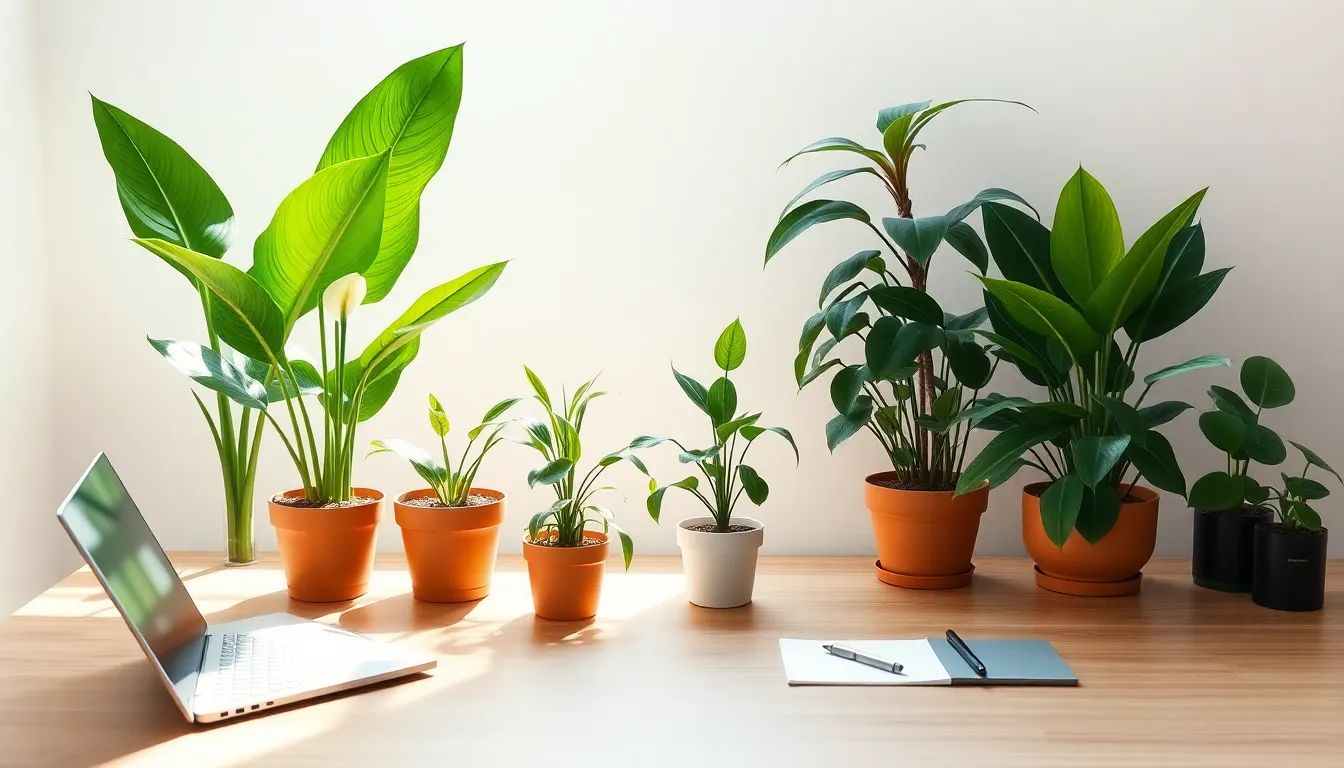
Beyond the low-light champions we’ve covered, certain plants excel specifically at removing harmful toxins from indoor air. These natural air purifiers work tirelessly to eliminate common office pollutants while adding visual appeal to your workspace.
Peace Lily
Peace lilies stand out as exceptional air purifiers that tackle multiple indoor toxins simultaneously. These elegant plants remove ammonia, benzene, and formaldehyde from office air while controlling mold spores that can compromise indoor air quality. Their distinctive white blooms and dark green foliage create a sophisticated appearance that complements professional environments. We recommend placing peace lilies in areas with bright, indirect light where they’ll thrive while continuously filtering your office air.
Spider Plant
Spider plants earn their popularity through remarkable ease of care and impressive pollutant removal capabilities. These hardy plants effectively eliminate formaldehyde and carbon monoxide from indoor spaces, making them ideal for offices with potential chemical exposure. Their cascading green and white striped leaves create natural visual interest while tolerating typical office conditions with minimal attention. We find spider plants particularly valuable because they thrive in indirect light and can handle irregular watering schedules that busy professionals often maintain.
Rubber Plant
Rubber plants deliver powerful formaldehyde removal capabilities wrapped in stunning visual appeal. These sturdy plants feature large, glossy leaves in deep burgundy or pink-tinged colors that bring vibrant energy to any office space. We appreciate rubber plants as one of the most resilient ficus varieties, perfectly suited for office environments where consistent care might be challenging. Their ability to efficiently filter formaldehyde makes them particularly valuable in offices with new furniture, carpeting, or building materials that may off-gas this common indoor pollutant.
Pick Low-Maintenance Varieties for Busy Work Schedules
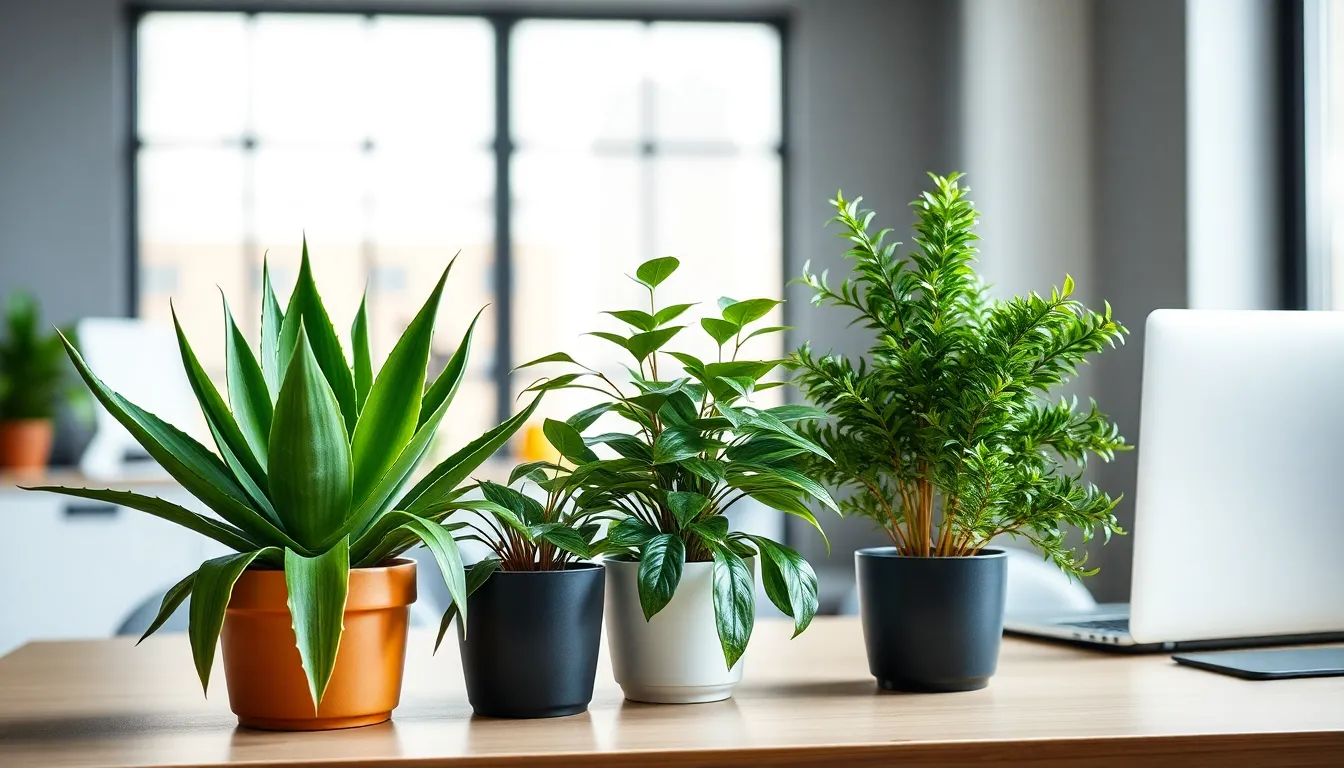
We’ve selected three exceptional plants that thrive with minimal attention, perfect for professionals who want office greenery without constant care.
Aloe Vera
Aloe Vera stands out as the ultimate drought tolerant office companion with its thick, fleshy leaves that store water for weeks. This succulent requires watering only when the soil becomes completely dry, making it incredibly forgiving for busy schedules. We love how it thrives in bright, indirect light while tolerating lower light conditions typical of office spaces.
The plant’s air purifying qualities actively improve your workspace environment while the medicinal gel inside its leaves provides a natural remedy for minor cuts or burns. Its compact size fits perfectly on desks, windowsills, or shelves without taking up valuable workspace. Aloe Vera’s resilience to neglect makes it our top recommendation for professionals who travel frequently or work long hours.
Philodendron
Philodendrons belong to the aroid family and excel in low light conditions that challenge most other plants. These adaptable beauties feature attractive green foliage in various leaf shapes and sizes, adding visual interest to any office corner. We appreciate how they thrive under indirect office lighting without losing their vibrant appearance.
Their minimal watering needs align perfectly with busy work schedules since they prefer soil to dry between waterings. The plant’s natural pest resistance eliminates concerns about insects or disease management in professional environments. Philodendrons adapt seamlessly to indoor office conditions, making them one of the most reliable choices for workspace greenery.
Chinese Evergreen
Chinese Evergreen (Aglaonema) earns recognition as one of the most durable houseplants suitable for demanding office environments. This resilient plant survives in low light conditions where other varieties struggle, making it ideal for interior offices or cubicles with limited natural light. We find its variegated leaves create stunning decorative accents that enhance any workspace aesthetic.
The plant tolerates moderate neglect while requiring only occasional watering when soil feels dry to the touch. Its air purifying benefits actively remove toxins from office air, contributing to a healthier work environment. Chinese Evergreen’s exceptional durability and low maintenance requirements make it perfect for professionals who want beautiful plants without intensive care routines.
Consider Desk-Friendly Compact Plants for Small Spaces
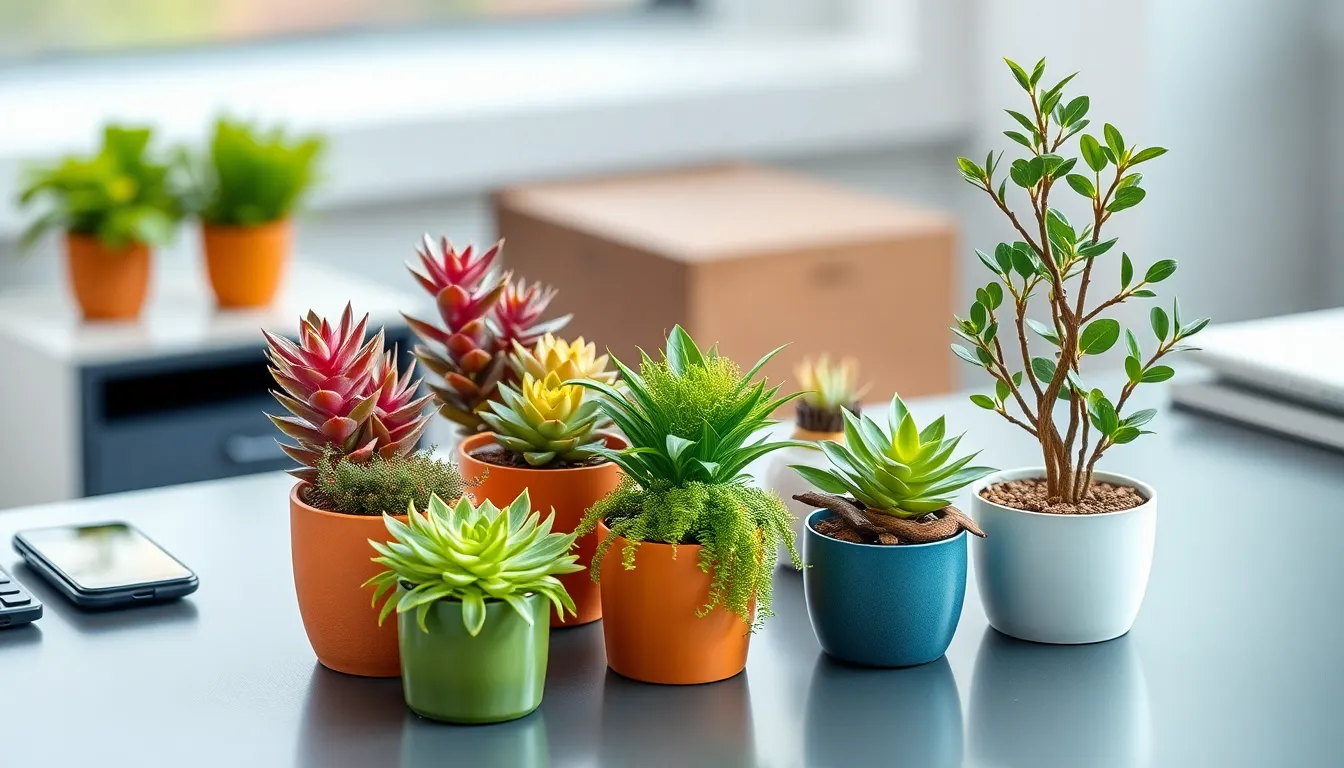
When desk space is limited, we need plants that deliver maximum impact without overwhelming our workspace. These compact options prove that size doesn’t determine effectiveness when it comes to transforming our office environment.
Succulents
Succulents offer the perfect solution for busy professionals who want beautiful plants without complex care routines. These small, fleshy plants store water in their leaves, requiring watering just once every 2-3 weeks. We can choose from varieties like jade plants, echeveria, or haworthia that fit perfectly on desks without taking up valuable work space.
Their drought-resistant nature makes them incredibly forgiving if we forget to water them during hectic work periods. Most succulents thrive in the bright, indirect light commonly found near office windows. They contribute to air purification while adding visual interest with their unique shapes and colors ranging from deep greens to silvery blues.
Small Ferns
Small ferns bring lush, tropical vibes to our workspace while naturally increasing humidity levels around our desk. These compact varieties like Boston ferns or maidenhair ferns typically grow 6-12 inches tall, making them ideal for small office spaces. We benefit from their ability to thrive in low to medium light conditions commonly found in office environments.
Ferns excel at removing indoor air pollutants while creating a calming, natural atmosphere that can reduce stress during demanding workdays. They prefer consistent moisture, so we’ll need to check the soil weekly and mist them occasionally to maintain optimal humidity. Their feathery fronds add texture and movement to our desk setup without blocking our view or cluttering our workspace.
Mini Bamboo
Mini bamboo, also known as lucky bamboo, brings tranquility and elegance to our office desk with minimal maintenance requirements. These aren’t true bamboo plants but rather Dracaena sanderiana, which adapts perfectly to indoor office conditions. We can grow them in water or soil, with water-grown varieties being particularly low-maintenance and visually striking.
They tolerate low light conditions exceptionally well, making them suitable for cubicles or offices without direct sunlight access. Mini bamboo plants typically reach 6-24 inches in height, fitting comfortably on most desk surfaces. Their clean, architectural lines complement modern office aesthetics while symbolizing growth and prosperity in many cultures, potentially boosting our motivation and positive mindset during work hours.
Install Statement Plants to Enhance Office Aesthetics
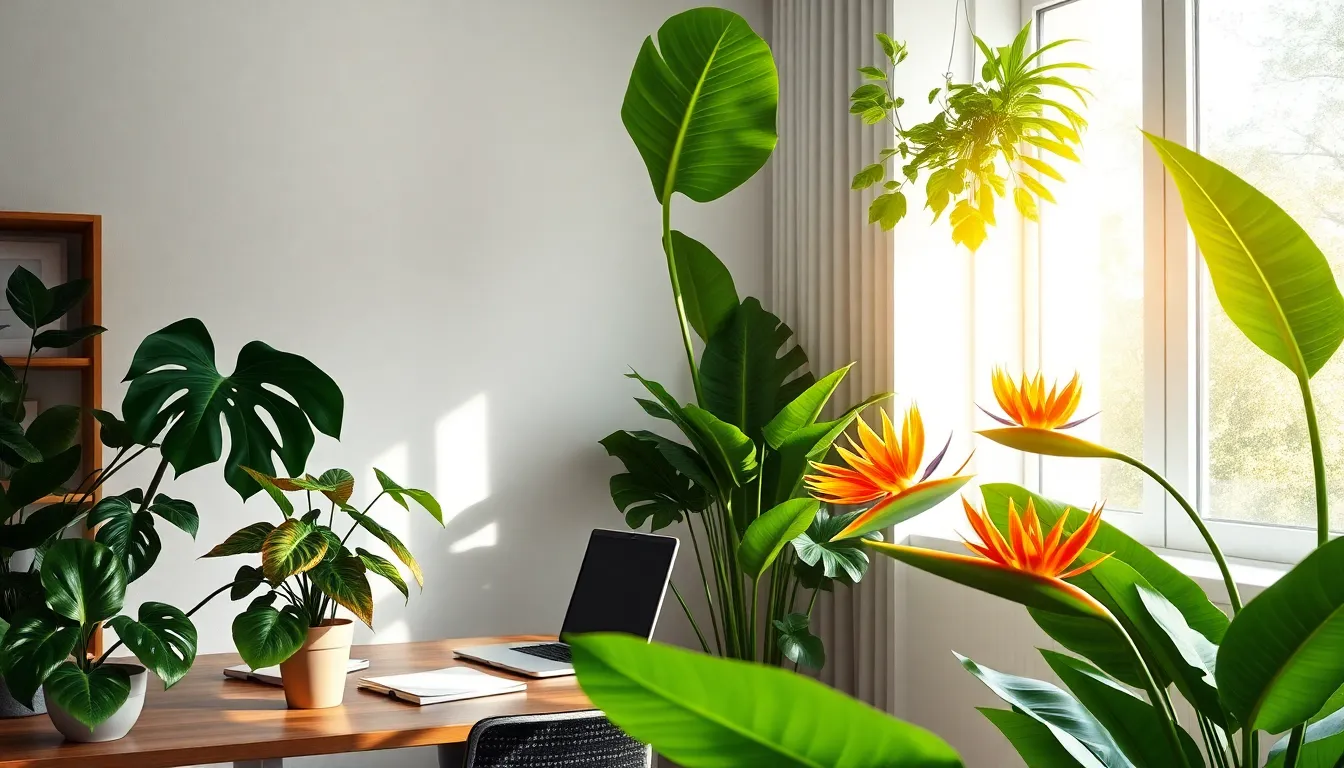
Beyond compact desk plants and low-maintenance options, we can transform our office spaces with bold statement plants that serve as natural focal points. These larger specimens create dramatic visual impact while delivering the same productivity and air quality benefits we’ve discussed.
Fiddle Leaf Fig
Fiddle Leaf Fig (Ficus lyrata) stands as the ultimate office statement plant with its large, glossy leaves that instantly elevate any workspace. This tropical beauty adds an elegant yet bold presence that commands attention without overwhelming the room. We’ll find its distinctive violin-shaped leaves create natural conversation starters during client meetings and team gatherings.
Position your Fiddle Leaf Fig near bright, indirect light sources like conference room windows or reception areas. The plant thrives in consistent lighting conditions and doesn’t tolerate frequent moves well. We recommend choosing a permanent spot where it can establish itself and grow into a stunning focal point over time.
Maintenance requires weekly watering and occasional leaf cleaning to maintain its signature glossy appearance. The plant prefers well-draining soil and benefits from a consistent watering schedule. We can easily incorporate this care routine into our weekly office maintenance tasks.
Monstera Deliciosa
Monstera Deliciosa creates an instant tropical atmosphere with its dramatic split leaves that develop unique patterns as the plant matures. This Instagram-famous plant brings a modern, sophisticated look that appeals to creative professionals and tech companies alike. We’ll appreciate how its fenestrated leaves add architectural interest to plain office walls and corners.
Growing conditions favor bright, indirect light and moderate humidity levels commonly found in office environments. The plant adapts well to typical office temperatures between 65-75°F and doesn’t require specialized care equipment. We can place it in lobbies, break rooms, or open workspace areas where its spreading growth pattern has room to shine.
Propagation offers an excellent opportunity to expand our office plant collection or share cuttings with colleagues. Simply cut below a node and place in water until roots develop. We’ll find this sharing aspect builds team camaraderie while extending our green office initiative throughout the workplace.
Bird of Paradise
Bird of Paradise (Strelitzia reginae) delivers the most dramatic tropical impact with its bold paddle-shaped leaves and potential for stunning orange and blue flowers. This showstopper plant transforms ordinary office spaces into resort-like environments that energize employees and impress visitors. We’ll notice immediate mood improvements when this vibrant plant anchors our common areas.
Placement requirements include bright, direct light near south-facing windows or under strong artificial lighting systems. The plant needs at least 6 hours of bright light daily to maintain its bold foliage and encourage flowering. We should position it in reception areas, atriums, or conference rooms with excellent natural light exposure.
Growth potential reaches 6-8 feet indoors, making it perfect for offices with high ceilings and spacious layouts. Regular rotation ensures even growth while occasional misting supports the tropical humidity preferences. We can expect this investment to become a signature element of our office design that supports both aesthetics and employee well-being for years to come.
Position Plants Strategically for Maximum Impact and Health
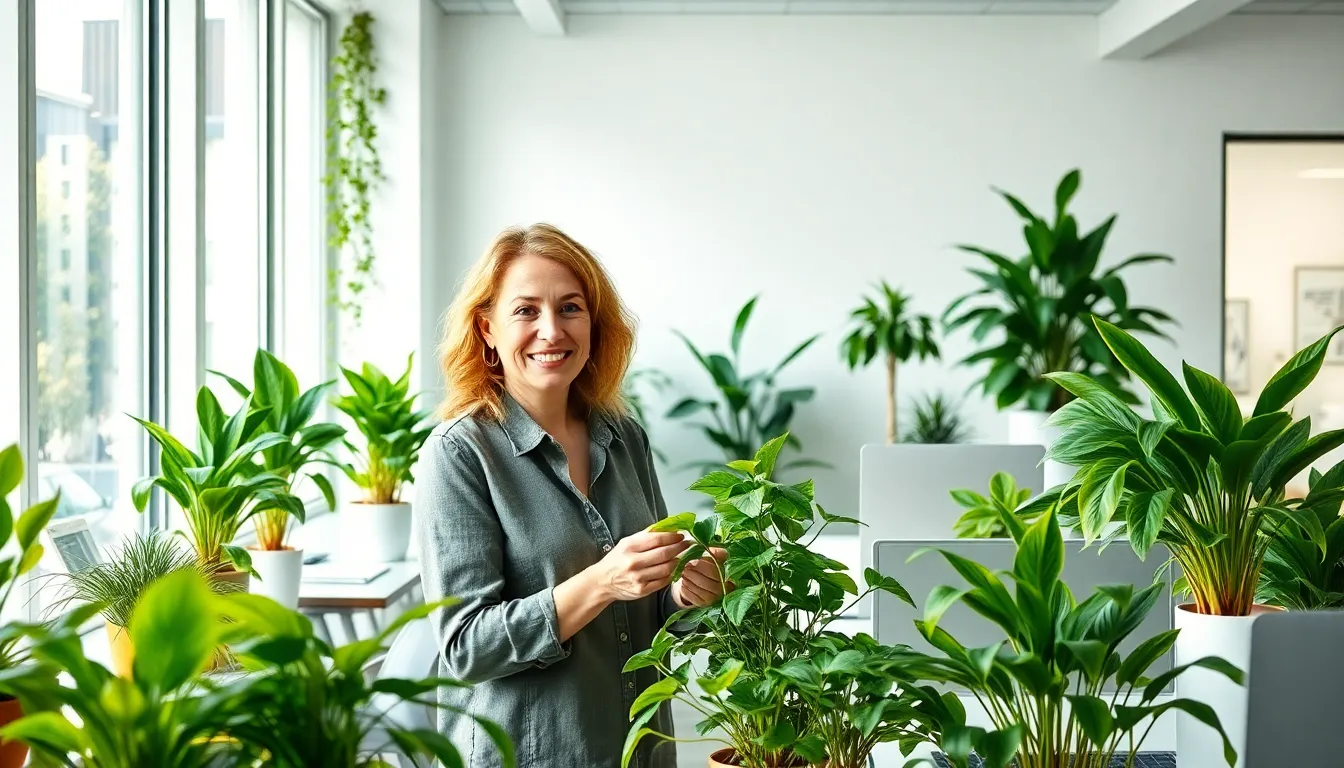
Now that we’ve selected our perfect office plants, proper placement becomes crucial for maximizing their health benefits and visual appeal.
Near Windows for Natural Light
Windows provide the ideal environment for most office plants since natural light supports photosynthesis and ensures long-term plant vitality. We recommend positioning plants within 3-6 feet of windows where they can receive bright, indirect sunlight throughout the day. Many common office varieties like pothos and snake plants thrive in these moderate light conditions without risk of leaf burn. Natural light also helps maintain the plants’ air-purifying capabilities at peak performance, ensuring we receive maximum benefits from their presence.
Away from Air Vents
Air vents pose one of the biggest threats to office plant health, creating temperature extremes and rapid moisture loss that stress plants significantly. We should keep our green companions at least 6 feet away from heating and cooling vents to prevent leaf damage and root shock. Cold drafts from air conditioning can cause leaves to yellow and drop, while hot air from heating systems quickly dries out soil and foliage. Strategic placement away from these areas helps maintain consistent growing conditions and extends plant lifespan considerably.
In High-Traffic Areas for Visibility
High-visibility locations maximize the psychological and productivity benefits that office plants provide to our entire team. We gain the most value by placing plants in reception areas, break rooms, and main corridors where employees encounter them frequently throughout their workday. Studies show that visible plants contribute to a 15% productivity increase when employees can see at least one plant per square meter from their desks. Common areas also allow us to showcase larger statement plants that might not fit individual workstations but still provide stress-reducing benefits to everyone who passes by.
Maintain Your Office Plants with Simple Care Routines
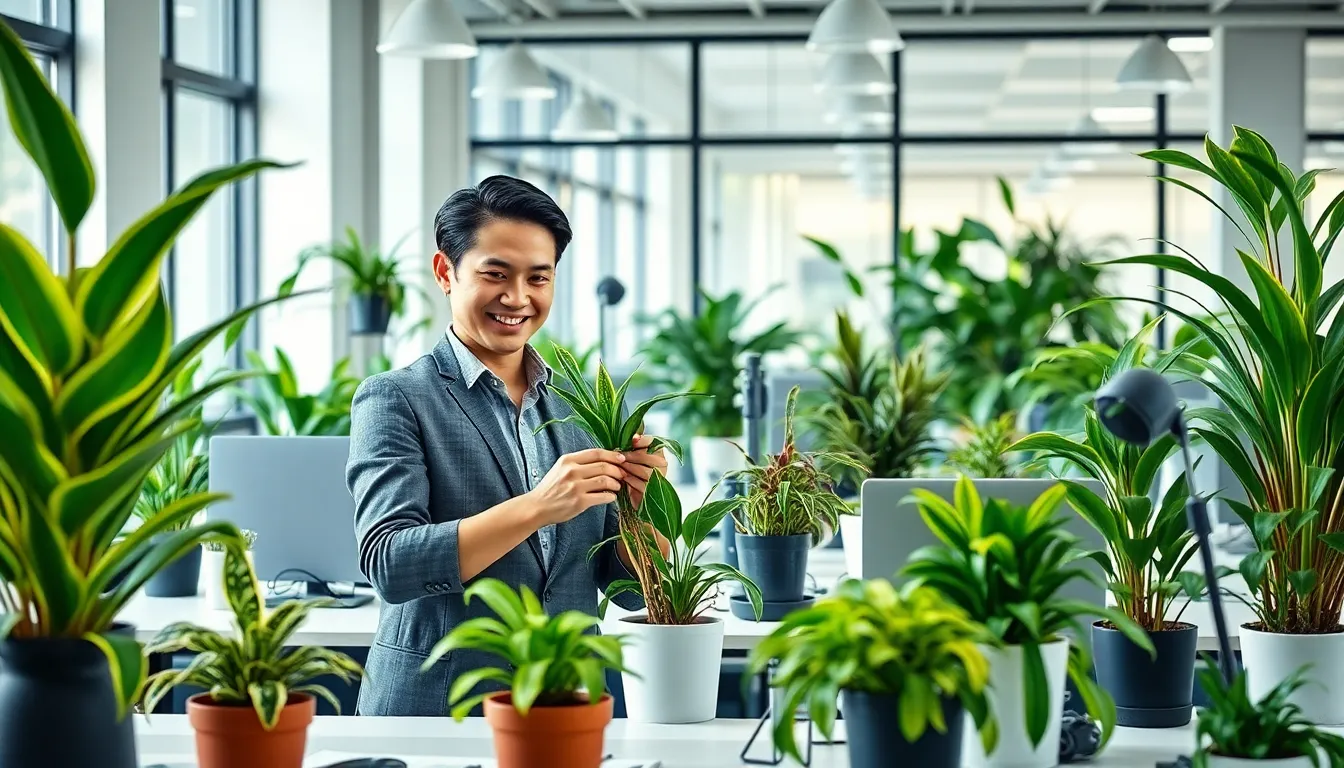
Successful office plant care doesn’t require complex schedules or extensive horticultural knowledge. We’ve developed proven strategies that keep your workplace greenery thriving with minimal effort.
Watering Schedule Tips
Choose resilient plants like snake plants, ZZ plants, and Chinese evergreens that tolerate low maintenance watering schedules perfectly. These hardy varieties forgive occasional watering mistakes while maintaining their vibrant appearance throughout busy work weeks.
Allow the top soil to dry slightly between waterings for most office plants to prevent root rot and overwatering issues. This simple technique works for approximately 80% of common workplace plants including pothos, philodendrons, and rubber plants.
Ensure proper drainage in all plant containers by selecting pots with drainage holes or adding a layer of pebbles at the bottom. Plants like lemon balm need consistently moist soil but quickly develop problems when water pools around their roots.
Consider your office environment factors including humidity levels, air conditioning, and heating systems when determining watering frequency. Most office plants require watering every 7-14 days depending on these environmental conditions and pot size.
Light Requirements
Position plants in indirect light locations such as desks positioned 3-6 feet from windows or cubicle areas with ambient lighting. Spider plants, snake plants, and ZZ plants excel in these moderate light conditions that characterize most office environments.
Use flexible plants like lemon balm that adapt to both full sun and full shade conditions for versatile placement options throughout your workspace. This adaptability makes them perfect for offices with varying light zones and changing seasonal conditions.
Avoid direct harsh sunlight streaming through office windows as it can scorch delicate leaves and cause permanent damage to many indoor plant varieties. Filtered or diffused natural light provides optimal growing conditions without the risk of leaf burn.
Supplement with artificial lighting in darker office areas using LED grow lights positioned 12-18 inches above plants for 8-10 hours daily. This approach extends your plant placement options to interior spaces without natural light access.
Pruning and Cleaning
Remove dead or yellowing leaves regularly using clean scissors or pruning shears to maintain plant health and prevent pest problems. This weekly maintenance task takes just minutes but significantly improves your plants’ appearance and vitality.
Wipe leaves gently with a damp cloth monthly to remove dust buildup that blocks light and reduces the plant’s air purification capabilities by up to 30%. Clean leaves photosynthesize more efficiently and contribute better air quality improvements to your office space.
Trim overgrown branches to maintain desired plant shape and encourage new growth in sparse areas. Strategic pruning every 2-3 months keeps plants looking professional and prevents them from overwhelming desk spaces or walkways.
Inspect for pests during each cleaning session by checking leaf undersides and soil surfaces for common office plant problems like spider mites or aphids. Early detection prevents infestations that can spread to other plants and damage your entire office garden collection.
Conclusion
We’ve shown you how office plants can dramatically transform your workspace from sterile to spectacular. Whether you choose low-maintenance succulents for your desk or statement plants for common areas the benefits remain clear – better air quality healthier employees and increased productivity.
The key to success lies in matching the right plants to your exact office conditions and maintaining simple care routines. With proper placement and minimal attention these green companions will thrive alongside your team.
Ready to breathe new life into your workplace? Start small with one or two plants and watch as your office environment – and your team’s well-being – flourishes naturally.
Frequently Asked Questions
What are the benefits of having plants in the office?
Office plants significantly reduce stress levels, improve air quality by filtering toxins, and boost productivity. They transform sterile work environments into more vibrant spaces, helping combat Monday morning blues and creating a more pleasant atmosphere for employees.
Which plants are best for low-light office conditions?
Snake Plant (Sansevieria), ZZ Plant (Zamioculcas zamiifolia), and Pothos are excellent choices for low-light offices. These plants are resilient, require minimal maintenance, and can thrive in typical office lighting conditions while still providing air-purifying benefits.
What are the top air-purifying plants for offices?
Peace Lily, Spider Plant, and Rubber Plant are exceptional air purifiers. They effectively remove common indoor toxins like formaldehyde and carbon monoxide while adding aesthetic appeal to your workspace with their unique foliage and occasional blooms.
Which office plants require the least maintenance?
Aloe Vera, Philodendron, and Chinese Evergreen are perfect for busy professionals. These drought-tolerant plants adapt well to neglect, require minimal watering, and can survive in various lighting conditions while still providing health benefits.
What are good desk plants for small office spaces?
Succulents, small ferns, and mini bamboo are ideal for compact workspaces. These plants fit easily on desks, require minimal care, and still provide air-purifying benefits and aesthetic appeal without taking up valuable workspace.
Can I have large statement plants in my office?
Yes! Fiddle Leaf Fig, Monstera Deliciosa, and Bird of Paradise make excellent statement plants for larger office spaces. They serve as natural focal points, enhance aesthetics dramatically, and contribute significantly to employee well-being.
Where should I place plants in my office for best results?
Position plants near windows for bright, indirect sunlight, but keep them away from air vents to prevent temperature stress. Place them in high-traffic areas to maximize visibility and psychological benefits for all employees.
How often should I water my office plants?
Allow the topsoil to dry slightly between waterings to prevent root rot. Most office plants prefer this approach rather than frequent watering. Always ensure containers have proper drainage to avoid water-logged soil.
Do office plants need special lighting?
Most office plants thrive in bright, indirect light. If your office lacks natural light, consider using artificial grow lights to supplement. Avoid placing plants in direct sunlight, which can scorch their leaves.
How do I maintain healthy office plants with a busy schedule?
Follow simple routines: water when topsoil is dry, position plants properly for light, and occasionally prune dead leaves. Regular cleaning of leaves improves appearance and prevents pest problems while requiring minimal time investment.







